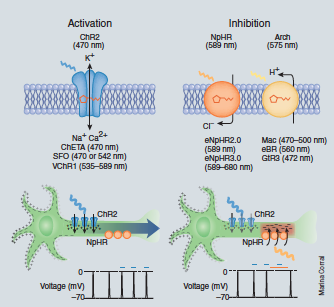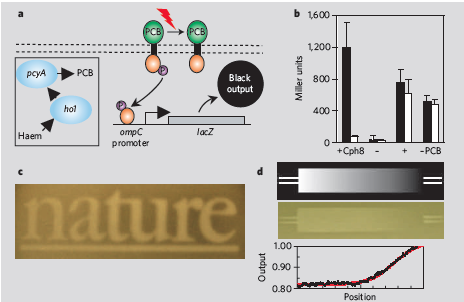CH391L/S14/ApplicationsofOptogenetics
Contents |
Introduction to Optogenetics
Optogenetics is a field of study that employs techniques from optics and genetics to control and study the functions of cells. In short, optogenetics involves the integration of extracellular genes to develop light sensitive proteins, strategies for targeted illumination, and finally, controlled readouts for reporting on changes in the cell.
A brief understanding of how optogenetics is applied; the 4 general steps for creating a light sensitive system:
- Step 1: Identify potential light sensitive proteins: Light sensitive proteins can be naturally occurring or chemically modified to become photosensitive. Photosensitive light proteins can be used to modulate membrane potential or modulate cell signaling. Examples will be provided later.
- Step 2: Delivering the genes: Genes coding these light sensitive proteins can be delivered to the target cells by transfection (deliberately inserting nucleic acids via non-viral techniques such as electroporation), viral transduction, or creation of transgenic animal lines.
- Step 3: Controlled illumination: Control of cellular activity depends on the well-defined temporal and spacial control of the illumination of light. There are several techniques for different desired effects. The 2012 Washington iGEM team designed a particularly useful application called "E. colight" that can control the illumination delivered to both a petri dish and a 96 well plate.
- Step 4: Reading the outcome: The effect induced by illumination of the photosensitive proteins must be measured in cells, tissues, and organisms. For example, electrodes can be used to monitor effects of membrane voltage.
The basics of optogenetics can be found here, at a previously created page from 2013.
Applications
Engineering E. Coli To See Light
In 2005, Levskaya et. al. published in Nature Magazine their experiment where they created a bacterial system that is dependent on red light to switch states. The system consists of a synthetic sensor kinase that phosphorylates the ompC promoter which allows the gene to be expressed. When exposed to light, the kinase is inhibited from phosphorylating the ompC promoter, and thus the lacZ gene cannot function. This is exemplified by the picture to the right of the "Nature" text. The bacteria were placed on an agar plate that contained S-gal. When functional, lacZ catalyzes the formation of a stable, insoluble, black precipitate from S-gal. The part in the middle was exposed to red light, thus inhibiting the bacterias ability to express the lacZ gene, which is why it is white. The surrounding black was not exposed to light, so the lacZ gene could function and degrade the S-gal.
How was this system made?
Using light to modulate cells is not a new concept. For millions of years, plants have interacted with light using phytochromes which are photoreceptive signaling proteins responsible for mediating seed germination, seedling de-etiolation, shade avoidance, and photosynthesis. However, E. Coli and other enterobacteria do not have photoreceptors, so for this experiment a chimaera was created that uses a phytochrome from a cyanobacterium. A phytochrome is a two-component system that is made up of a membrane bound, extracellular sensor that responds to light, and an intracellular response regulator. In this case, the response regulator was bound to an E. coli intracellular histidine kinase domain. The next challenge faced was that the part of the photoreceptor that responds to light, phycocyanobilin, is not naturally produced in E. Coli. So, two phycocynaobilin-biosynthesis genes were inserted, and a pathway was introduced that can convert haem into phycocyanobilin. As described above, the working phytochrome modulates the activity of the ompC promoter, thus controlling the lacZ gene expression.
Neuroscience
Optogenetics can be a powerful tool for monitoring the activity of individual neurons in living tissue. It uses light to control the activity of neurons that have been modified to express light sensitive proteins. There are two important proteins that modulate the activity of neurons: channelrhodopsins, and halorhodopsins, that are both part of the opsin family of proteins.
- Channelrhodopsins: are cation channels that produce depolarization of neurons when illuminated. They function as light gate ion channels.
- Halorhodopsins: are another light gated ion channel that can be used to inhibit the action potentials of mammalian neurons.
In order to
Optogenetic control of epileptiform activity
Future Directions
In 2010, a collaborative project called OpenOptogenetics was created by Guillaume P. Dugué, in an effort to promote, facilitate, and democratize the use of optogenetic approaches in biological research. The website states on its homepage:
"OpenOptogenetics provides background knowledge, an inventory of available optogenetic tools and their characteristics, tips and protocols, reviews of commercially available equipment and bibliographic references. OpenOptogenetics is an open wiki, just like Wikipedia, and therefore is also an attempt to promote “open research”, where researchers make clear accounts of their methodology and share them with their colleagues without the intermediary of a publication."
OpenOptogenetics could be a powerful tool when working with optogenetics in future research.
iGEM applications
As stated before, the 2012 Washington iGEM team used optogenetics for protein regulation that functioned similarly to the Levskya et. al. experiment. They also developed techniques that allowed them to use technology to provide the light to modulate the cells. They cleverly called their app "E. colight.". Their overall project for that year was named "Apptogenetics," as they had developed many different types of technological apps to aid them in their experiments.
The University of Technology in Munich Team in 2010 created a bacterial constructed 3D structures by using light induced gene expression. This experiment also integrated non-canonical amino acids and recoding of the amber codon, and it could be useful for the 2014 iGEM team to look into their research.


